The Velocity has surprised me. Originally taken as a trade for banner space, I put it in my list of things to review. Straight up I now own the thing. I have frozen it in the freezer, submerged it, shot with it, competed with it, and I am finally ready to write about it in more detail. First off, the optic retails for $639 and that’s a nice chunk of change. Hard to justify for what some consider an unknown brand. The market for the Atibal isn’t the budget consumer, it’s targeted at other mid-range optics such as the Vortex Viper PST, the SWFA HD, and the Leupold VXR-Patrol. Some of these competing brands cost more, some cost less. All of them are considered mid-range glass. Whatever you do, don’t compare it to the Strike Eagle.
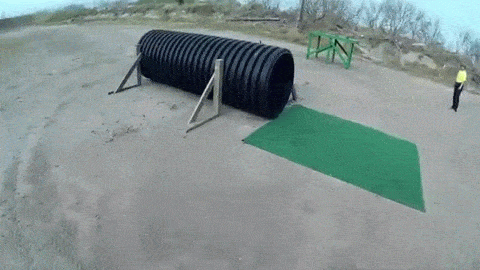
So what are we getting for the money? One of the key notes is that this is a fully Japanese manufactured optic. We all know and respect the value of a Japanese optical instrument. Of the aforementioned optics, I believe the SWFA HD is the only other mid-range competitor with Japanese glass, but the HD is $799 and thus jumps another Benjamin +$50 on top of the Velocity. This is the most affordable Japanese optic on the market, and overall the quality is superb. Let’s take a look.
Fit, Finish, and Features:
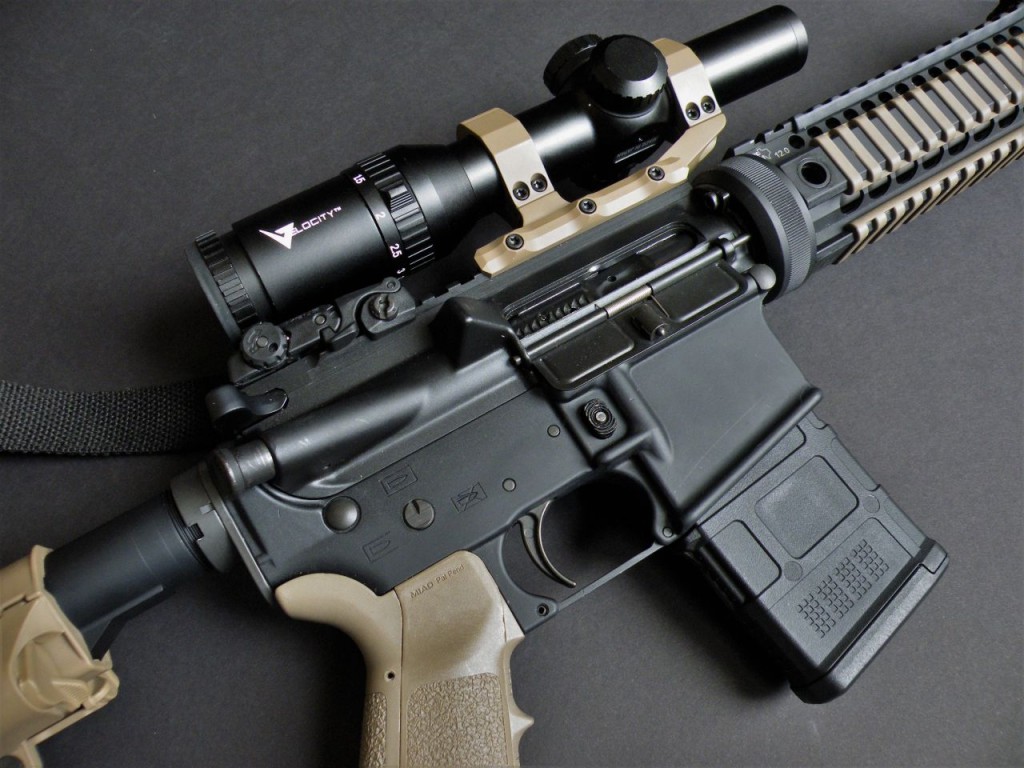
Pre-Review Clean and Nice in a Aero Precision Mount
Overall appearance and laser etching is superb. The optic mainbody feels stout, and the anodizing is a clean flat black. The optic utilizes a gear drive to cam the magnification tube inside the optic, which means that only a small portion of the rear bell is weakened by any type of cut and it has no cam pin. Sounds good. The optic is 1-4x, first focal plane, and features seven setting illumination. The reticle reminds me of a German #4 except the fine crosshairs in the center are free-floating. The modified German #4 is a good choice for this FFP optic as the thin center crosshairs by themselves are far to small to be fast up close, but the thick bars at 3, 6, and 9 o’clock allow quick target bracketing up close. As you zoom in, you then can utilize the fine 0.9 MOA center crosshairs for more difficult / precision shots. The combination of FFP with the German #4 ish reticle compliments the optic well. If you like clean, uncluttered crosshair reticles, this one is a good choice. There is no BDC present etched into the crosshairs.
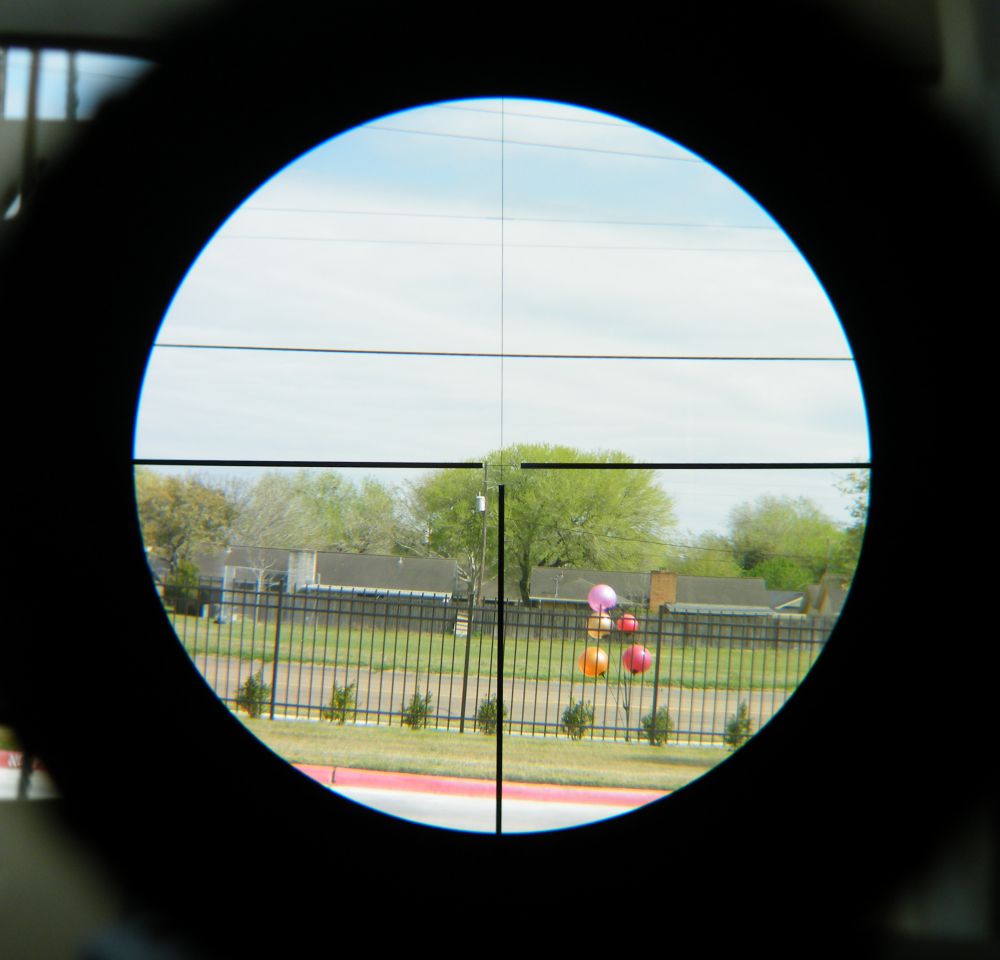
As always, pictures don’t do the optics much justice. I did my best, but I’m still looking through another pane of glass with the photos above.
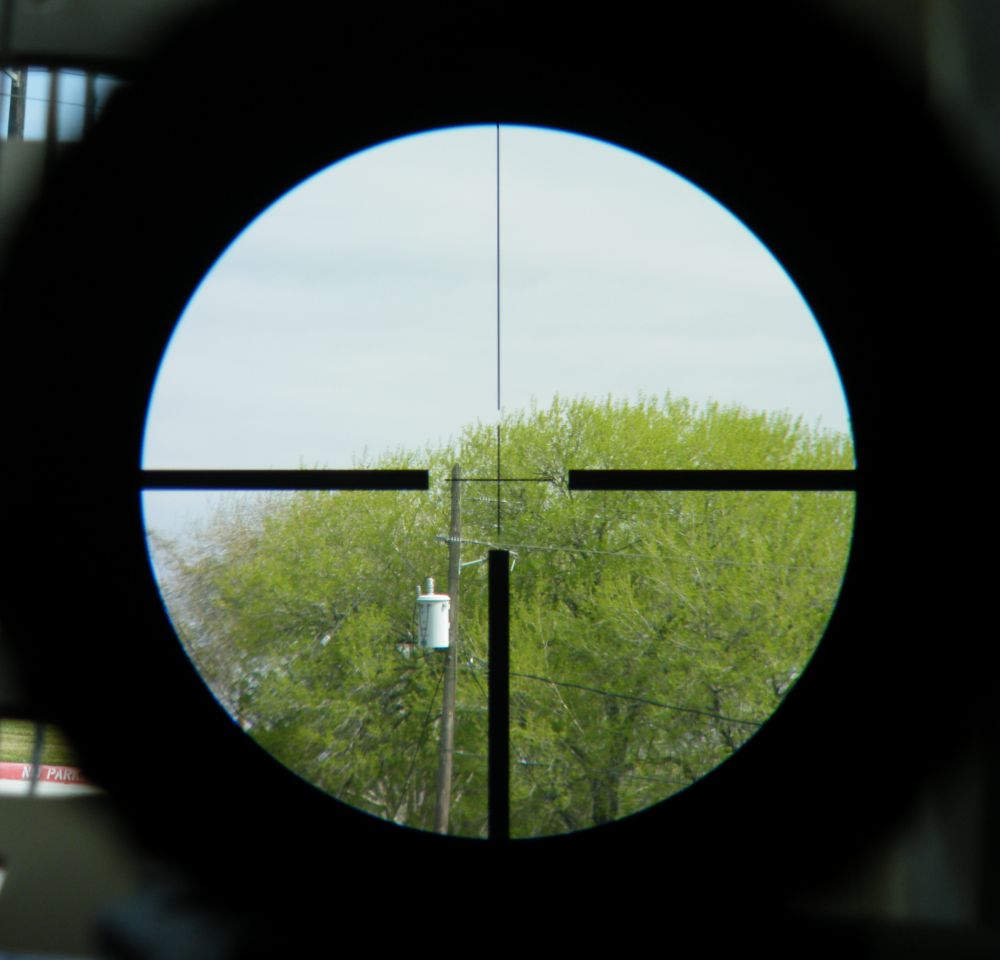
The illumination is not fully daylight bright. You should consider the illumination on the Velocity as a low light feature and let the reticles bold lines and fine crosshair do the work for you in the daytime setting. I found it to be quite useful in low light at setting 1. Utilized in this way, the optic can be run in low light with a crisp red center crosshair and a long battery life. If you shine your weapon light, the center red illuminated crosshair washes out, but those bold lines of the German #4 take over for excellent target contrast when you blast your light. I found this ideal. The reticle manages to work in a variety of conditions. On my practical rifle, I now have a optic which can be run with consistent performance in low light, day-light, and with a weapon light. It really changed my mind on what to look for in a variable, and as such I ditched the Razor HD and the Trijicon TA47-R for something with a reticle which permits use in a variety of conditions. I am now a believer in FFP in a low powered variable. A bold reticle that catches your attention but then moves away as you zoom in to reveal a precise reticle is something I didn’t know I was missing.
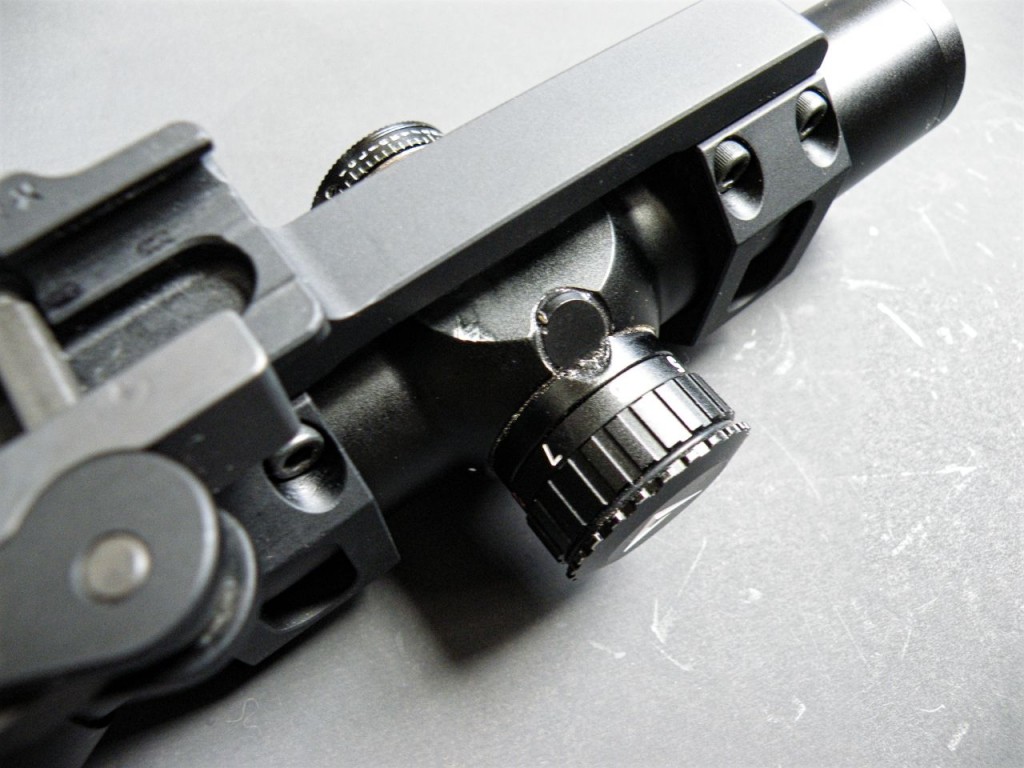
I have been working on this Patina. Since the match I switched out mounts, and I think the only way I can get the fine dust out is with a soap and water bath.
The manufacturer lists battery life at 800 hours for setting 1, 500 hours at setting 2, 320 hours at setting 3, 200 hours at setting 4, 130 hours at setting 5, 90 hours at setting six, and 60 hours at setting 7. Whew. So at setting 1 or 2, you have long battery life for low light shooting, and you can leave the optic switched on without worry.
Let’s talk about the turrets: What we have is a 1/2 x 1/2 MOA turret assembly that is capped and finger adjustable. The clicks are positive, audible, and actually nicer than those on my Razor HD. The Razor’s clicks felt tinny and small in comparison. The clicks are nicely spaced with a audible snap as the turret moves from click to click. There are 30 minutes per rotation on the optic. The optic is zeroed and then a small jewelers screwdriver is used to unlock the laser etched adjustment ring to line it up with your mechanical zero. The caps are present to cover your turrets from damage. The illumination ring is also nicely constructed and snaps to each position with an audible thunk and positive feel. It is powered by a common CR 2032 lithium battery.
The glass is clear, bright, and has a slightly warm tint. When compared to the Razor HD in my previous article, I had to struggle to tell the difference with a slight edge to the Razor. No artifacts or minutia are noted in the reticle. The glass is superb. The Velocity’s diopter adjustment rotates cleanly and the magnification ring has a stiff feel but is finger adjustable without a cat tail. The Velocity is compatible with the Switchview model 1762SV2 for a cat tail if you need one.
The eye relief is excellent, and in use on a cantilevered mount it gave me adequate room to get a clean sight picture for nose to charging handle shooting. The field of view is a bit narrower at 1x than competitors, but its not a sacrifice I found to be problematic as shooting both eyes open negates this issue when shooting up close.
In Use:
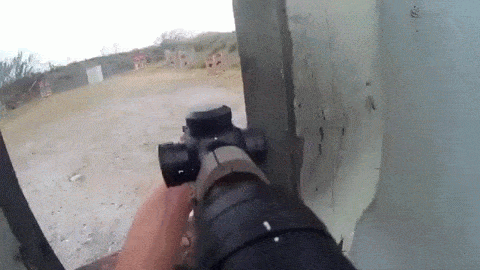
In use the optic gave me no drama at any range session or at my recent competition. The optic got quite gritty, dusty, and the windage cap took a few bumps from barriers but all without issue. The optic was clear, easy to use, and it reticle was fast up close and offered me some fine precision crosshairs when I zoomed in. Overall, in use, it worked perfectly well without concern of it spilling its guts. It’s a stout product. I adjusted the optic from round to round to suit the stage, and it hung in there without issue. It’s likely to survive anything I could throw at it and would be a good choice for someone who wants a solid optical product with a clutter free reticle for under $650 dollars. Nothing feels cheap here, and while the optic feels a bit Spartan in regards to its features compared to competing products, what’s here appears to be high build quality. Need quality Japanese glass on a budget for your three gun build? Here is the one. Waterproof with and without its caps, overall high quality construction, clear glass, and budget friendly price makes this one a good choice for a rough and tumble gun.
I have researched this product extensively. In my research, I have found that what this Japanese made optic amounts to is a Hakko optical product. It has been imported before under other names, and was introduced for a pretty penny at close to $1000 dollars from the other company. By no means is this a brand new optic, its been around a while and is well established from a manufacturing standpoint. Atibal’s customers chose the reticle in an online vote, Atibal spec’d it out, and brought it back to America.
I would like to see it developed further, perhaps a gen 2 could incorporate a non caliber specific BDC of 2 MOA drops along the fine center crosshair and for the love of God keep the bold lines at 3, 6, and 9. Those bold lines help immensely in differing light conditions and when you activate a weapon light. A final wish list item would be low profile exposed turrets for shooters who want to play with elevation and windage on the fly without removing the caps. As it is, it’s a high quality product at a price point that sets it apart from its Chinese, Phillipine, and “who knows where its made” competition. Having been to Academy sports and outdoors the other day, I went over to the scope section where you can handle optics on display. While none of the optics present on display were mid grade or what I would consider high end, all the Bushnells, Burris, Nikons, and Leupolds that I examined that day made me say yuck as I rotated the turret assembly and examined the fit and finish. I’m a spoiled optical brat now, and if you value simple, rugged optics with excellent glass, this one lands at a price point to quality ratio that makes it very attractive.
As previously compared to my Razor, I think its a more realistic purchase for most shooters… and the spirit of the blog has always been to identify tips, techniques, gear, and thoughts on becoming a better Rifleman in a way that appeals to the common man. The Razor is something most of us won’t ever own and in its own right is a fantastic optic, but the Velocity is more within the reach of everyman by far. It’s affordable, Japanese, and insofar appears to be tough enough for us to consider serious gear and not a toy.
Final Say: Recommended
Specs:
- Objective Lens Diameter: 24mm
- Eye Relief: 4.8 inches
- Field of View: 27.5-63 feet / 100 meters
- Tube Size: 30 mm
- Turret Style: Low Cap
- Adjustment Per Click: 1/2 MOA
- Max Elevation Adjustment: 120 MOA
- Max Windage Adjustment: 120 MOA
- Weight: 18 ounces with no mount
- Length: 10.25 inches
- Made of 6061-T6 aircraft grade aluminum





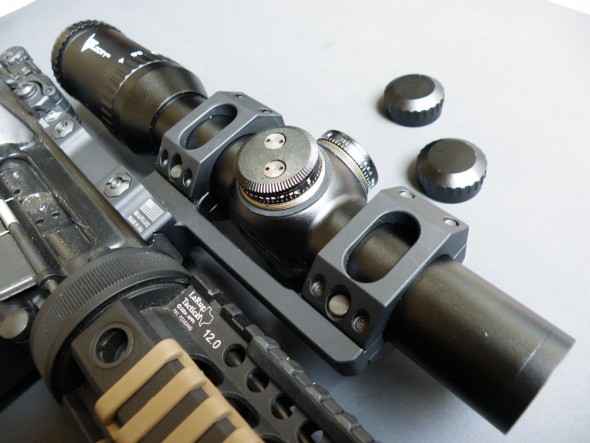



How’d the Aero mount do? Why’d you switch?
I just like quick detach, the Aero Mount is great for a lightweight build.
I’ve been recommending the Velocity to folks based on your write ups. It seems like a great scope for the market segment. Are you planning on sticking to this one for the new CMP service rifle rules?
I’m considering picking up a dedicated upper for CMP, as none of my current uppers would be considered legal (they use brakes and comps).
When I can make it to another HP match, I will definitely bring the Velocity along. It’s legal where as my Razor was not, and other shooters have vouched for its repeatability and clarity on the US Rifle Team forums. It could use some target turrets for those guys, but there would be no issue adjusting the stock turrets by hand.
Lothaen ..
What’s your opinion of the bleed-thru of the illumination (front / rearward .. at the targets / shooters end) of the scope?
The illumination is not a deal breaker for me .. but it’s annoying from my perspective. Otherwise this is the best sub-1000 dollar scope I own. I bought 4 of them .. very fast and accurate .. this is my 3-gun and hunting scope of choice.
I have yet to get a swfa 1-4x classic to do a comparison .. it’s still in the works .. how bout your side by side .. how’s that coming?
Thanks
Unfortunately obtaining a SWFA optic is on the backburner after the costs of moving. I had a extra $2200 that went straight down the toilet in moving costs and lease breakage fees so there went any optic money for the time being.
My main concern is to get a killflash for it, as the light bleed from the front is pretty obvious if you wanted to be a little stealthy then it would be a visible issue at night. Readers should know that many of these optics which use a full reticle illumination really just splash the portion of the reticle with light of which some bleeds out the front, so this just isn’t a concern with the velocity. I think a killflash would help a bunch. Midway USA sells the sungaurd killflash ARD which is sandwiched between the scope and the butler creek flip cover. I have to measure the scope and order the cover and killflash for a future post when I get around to that project.
As far as the rear bleed, if I am in pitch black I notice it more, but when looking outside in the streetlights and neighborhood it doesn’t detract from my attention. I haven’t taken it out to my country property at night which has no natural light, so I am not sure how the moon/overacast conditions would look with some of the light spill. I am glad you like the Velocity as well. It’s really a gem and its my favorite general purpose optic that I have tried thus far.
Agreed (re: it’s a gem).
I don’t run the illumination .. it’s un-necessary .. for my applications. Thanks for the update.
I hate moving too (e.g. it’s a real time and money killer).